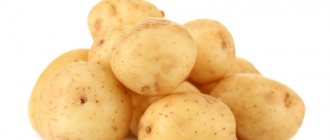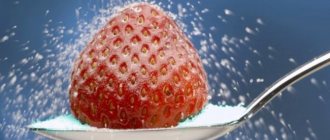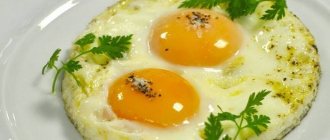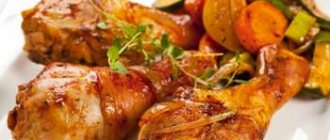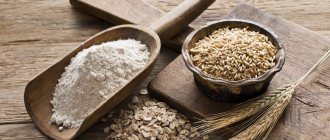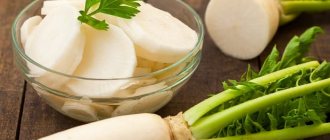Egg yolk is a food product that is a symbiosis of nutrients, vitamins, and mineral compounds necessary for the development of each organism. Its chemical composition and color depend on the bird's food.
The yolk supplies lecithin and vitamins A, , E, PP, D, K to the human body, normalizes the level of “bad” cholesterol, the functioning of the gallbladder, brain, nervous system, and has a positive effect on liver cells. A heat-treated product does not overload the digestive system and has a high degree of digestibility (up to 95%).
Interestingly, the proportion of yolk in a chicken egg is 27-32%, white - 56-61%. At the same time, 10-12% of the mass falls on the shell through which the chicken breathes. There are more than 7,500 pores concentrated on the egg shell, most of which are located at the blunt end of the product. It is through these holes that carbon dioxide and moisture are removed from the egg and oxygen enters.
Properties of egg yolk
Nutritional value and composition | Vitamins | Minerals
How much does an egg yolk cost (average price for 1 piece)?
Moscow and Moscow region.
4.5 rub.
Today, like many millennia ago, it is no secret to anyone that a chicken egg consists of a yolk and a white. The former is credited with a lot of healing qualities, but many representatives of a healthy lifestyle neglect the beneficial properties of egg yolk, citing the fact that it is full of fat and cholesterol. But we'll talk about this later.
In cooking, egg yolk is in high demand, if only because of its excellent binding properties, which are necessary for emulsifying ingredients. Take, for example, such classic sauces as mayonnaise or hollandaise - they simply cannot be prepared without this ingredient.
In addition to sauces and mayonnaise, egg yolk is used as a thickener, as well as to enrich the texture of the finished dish when preparing custard for cakes, puddings and other dishes. And what about the famous egg liqueur, which always contains yolks! By the way, experienced chefs, when working with egg yolks for preparing sweet dishes, advise grinding them with sugar only in earthenware or porcelain dishes.
Eggs in bodybuilding
Professional athletes carefully monitor their diet because they know how important proper nutrition is to obtain the desired result. The main goal of athletes is to build muscle mass. To complete the task, you need to adhere to the established training regimen, replenish the deficiency of nutrients after exercise, focus on protein foods or all kinds of supplements: gainers, proteins. However, adherents of a healthy diet always insist that the human body absorbs nutrients better from natural products than from synthetically produced chemical cocktails.
Eggs are considered the most affordable source of high-quality, easily digestible protein, which contains essential amino acids necessary for muscle growth. However, is there any benefit from yolk for athletes? Yes. When building muscle mass, it is no less valuable than protein. Firstly, it also contains amino acids. Secondly, the yolk improves protein absorption.
Benefits of egg yolk
Despite numerous protests, the benefits of egg yolk are beyond doubt, as it is the richest source of vital elements. For example, choline is responsible for fat and protein metabolism, and also has a beneficial effect on the activity of the nervous system. Melatonin, which is also found in egg yolk, plays an important role in the rejuvenation process, so it is simply necessary for the construction of new cells.
The benefits of egg yolk have also been scientifically proven for the cardiovascular system, due to the fact that it, being perfectly digestible, is an excellent supplier of omega-6 and omega-3 acids, which are not produced by the body on its own.
Chemical composition
Egg yolk is a source of vitamin E, which supports the health of human reproductive organs. As an antioxidant, it fights cancer cells by destroying free radicals. Its effectiveness in improving the condition of hair, nails and skin has been noted. The yolk is of particular value for pregnant women, as it reduces the likelihood of developmental defects in the fetus.
Currently, there is an opinion that cholesterol concentrated in eggs poses a danger to human health. Indeed, yolks contain saturated fats that are unhealthy for the body. However, they are balanced by valuable polyunsaturated ones, which normalize lipid metabolism, regulate vascular tone, prevent metabolic and cardiovascular disorders, ensure the synthesis of anti-inflammatory prostaglandins, and improve microcirculation.
Egg yolk delays the rapid passage of food through the stomach into the intestines. Due to this, the accumulation of glucose slows down, little insulin is produced, and less subcutaneous fat is formed.
The weight of one egg depends on the type of bird and is:
- quail – 10 g;
- guinea fowl – 25 g;
- chicken – 50 g;
- pheasant – 60 g;
- turkey - 75 g;
- duck – 90 g;
- goose – 200 g;
- emu – 780 g;
- ostrich – 900 g.
The yolk accounts for a third of the egg's mass.
The uniqueness of the yellow fraction of the product lies in the content of an active anti-sclerotic agent - lecithin, which nourishes nervous and brain tissue. In addition, the substance is necessary for the proper functioning of the biliary tract and liver, regulation of the distribution of adipose tissue. Nutritional value of raw egg yolk
| Components | Content per 100 g of product, g |
| Water | 52,31 |
| Fat (g) | 26,5 |
| Proteins (g) | 15,9 |
| Monounsaturated fatty acids | 11,738 |
| Saturated fatty acids | 9,551 |
| Essential amino acids | 7,869 |
| Nonessential amino acids | 7,758 |
| Polyunsaturated fatty acids | 4,204 |
| Omega-6 | 3,976 |
| Carbohydrates (g) | 3,6 |
| Ash | 1,71 |
| Sterols | 1,085 |
| Mono- and disaccharides | 0,56 |
| Omega-3 | 0,228 |
Chemical composition of raw egg yolk
| Name | Nutrient content per 100 g of product, mg | |
| Vitamins | ||
| Choline (B4) | 820,2 | |
| Pantothenic acid (B5) | 2,99 | |
| Tocopherol (E) | 2,58 | |
| Riboflavin (B2) | 0,528 | |
| Retinol (A) | 0,371 | |
| Pyridoxine (B6) | 0,35 | |
| Thiamine (B1) | 0,176 | |
| Folic acid (B9) | 0,146 | |
| Niacin (B3) | 0,024 | |
| Cholecalciferol (D) | 0,0054 | |
| Cyanocobalamin (B12) | 0,00195 | |
| Phylloquinone (K) | 0,00007 | |
| Macronutrients | ||
| Phosphorus (P) | 390,0 | |
| Calcium (Ca) | 129,0 | |
| Potassium (K) | 109,0 | |
| Sodium (Na) | 48,0 | |
| Magnesium (Mg) | 5,0 | |
| Microelements | ||
| Iron (Fe) | 2,73 | |
| Zinc (Zn) | 2,3 | |
| Copper (Cu) | 0,077 | |
| Selenium (Se) | 0,056 | |
| Manganese (Mn) | 0,055 | |
100 g of fresh egg yolk contains 322 kcal, 1.094 mg of lutein and zeaxanthin, 0.088 mg of beta-carotene, 0.038 mg of alpha-carotene and 0.033 mg of beta-cryptoxanthin. Natural carotenoids reduce the likelihood of developing cataracts.
Why are fresh eggs harder to separate from their shells? The fact is that their contents adhere much more tightly to the film of the hard shell.
Egg yolk damage
Returning to the question of the dangers of egg yolk, one cannot but agree that it indeed contains a large amount of fat and cholesterol. However, these same fats help the production of the main male hormone - testosterone. And if we talk about cholesterol, then we should take into account that it can be not only harmful, but also simply necessary. In this case, it does not stay in the body, but is broken down, ensuring the production of the same hormones and vitamins.
Thanks to the results of recent studies, it has been proven that regular consumption of chicken yolks will in no way affect the increase in the level of bad cholesterol if men eat up to four eggs a day, and the fairer sex - one or two.
But do not forget that due to the high calorie content of egg yolk, overweight and obese people should not abuse these products, limiting their diet to egg whites.
Consumption rate
The recommended amount of proteins and yolks in the diet depends on the age and health status of the person.
Adult men and women can eat 1-2 eggs per day. If you have high cholesterol or blood sugar, your diet should be limited to 2 pieces per week.
Eggs can be included in the menu for children over 1 year of age. At this age, a child can eat 1 yolk per week. Protein is a strong allergen, so it should not be offered to children under 3 years of age.
By the age of 5, a child’s diet can include up to 5 pieces per week.
How to select and store
The characteristics are subject to the requirements of state standards. The shells of eggs that go on sale must be marked with letters and numbers. What does it mean?
- The letter designations “D” or “C” indicate the “age” of the product. “D” (dietary) - those that ended up on the counter within the first 7 days from the date of production. Such products can be purchased in the immediate vicinity of the production site. “C” (table eggs) are sold everywhere.
The degree of freshness is the main difference between products of categories “D” and “C”. Dietary eggs “older” than 7 days mechanically pass into the category of table eggs.
Photo: gulfnews.com
- Digital marking indicates mass. The higher the number, the lighter and smaller the egg. Selected product C0 (weight from 65 to 74.9 g) is heavier and larger than C1 (category 1 weighing 55-64.9 g). Large specimens weighing more than 75 g are marked with the letter “B” and belong to the highest category.
The taste and quality of eggs do not depend on their size and shell color.
In the store you should pay attention to 2 points:
- Date of manufacture. Eggs remain fresh for 25 days when stored at room temperature and 120 days when stored in the refrigerator.
- Manufacturer's address. The closer the manufacturing site is to the sales center, the better.
At home, eggs should be stored away from substances with strong odors. The optimal temperature is from 0 to 5°C.
You will learn about the freshness of eggs and beneficial properties from this talk show “About the Most Important Thing” with Sergei Agapkin and Doctor of Medical Sciences, leading researcher, professor of the Federal State Budgetary Institution of Science “Federal Research Center for Nutrition and Biotechnology”, doctor of the highest category, Alla Vladimirovna Pogozheva.
Calorie content of fried and boiled eggs
Cooking ensures easy digestion of food and maximum absorption of beneficial components.
Calorie content depends on the chosen cooking method. The nutritional value is affected by the duration of heat treatment and the list of ingredients involved in the recipe.
Boiled whites and yolks contain fewer calories than raw eggs. The longer the heat treatment, the lower their energy value.
| Cooking method | Cooking time in minutes | Kcal for 1 piece |
| "In the bag" | 1 | 80 |
| Soft-boiled | 4 | 70 |
| Hard-boiled | 8 | 50 |
The calorie content of fried eggs in the form of fried eggs or omelettes depends on the fat content of the oil and additives: milk, cheese, smoked meats, mushrooms, vegetables.
Photo: bbc.com
Average energy values per 1 serving of 2 eggs:
| Dish | Number of calories |
| Scrambled eggs without butter | 200 |
| Fried egg with vegetable oil | 340 |
| Egg white omelette | 90 |
| Classic omelette | 120 |
| Omelette with tomatoes | 160 |
| Omelet with cheese | 180 |
| Omelette with sausage | 200 |
Calorie content of egg dishes
The product is in demand internationally. “Egg” recipes are found in many national cuisines and represent a wide range of dishes - from breakfasts and salads to hot dishes and baked goods.
Photo: instructables.com
In cold appetizers, boiled whites and yolks are combined with sauces, vegetables, meat and fish ingredients. Egg salad will be a light or hearty dinner and will decorate the holiday table.
Thanks to the addition of eggs, soups and cabbage soup acquire richness and thickness. Sometimes the egg mixture is added to the broth in liquid form. In other cases, chopped boiled whites and yolks are poured into the finished soup and act as a decorative element.
The main hot dishes are European casseroles, Russian stuffed “nests” of vegetables and meat. The star of Caucasian cooking is Adjarian khachapuri, golden-brown bread cakes with cheese and an egg “core.”
In confectionery, a boiled egg serves as a filling for pies. Protein is the main ingredient for airy meringues. Croutons dipped in egg are a breakfast favorite for both adults and children.
In drinks, the egg mixture acts as a natural thickener and is an alternative to dairy additives.
Kaisermelange (“imperial mixture”) is a type of Viennese coffee with loose yolk and honey.
Popular options for dishes with added eggs and their energy value:
| Dish | Calorie content per 100 g. |
| Cold appetizers | |
| Egg with mayonnaise | 194 |
| Eggs with red caviar | 174 |
| Salad with tuna and mayonnaise | 270 |
| Salad with cucumber and sour cream | 70 |
| First meal | |
| Cabbage soup with sorrel | 36 |
| Chicken broth soup | 40 |
| Beetroot | 37 |
| Okroshka | 75 |
| Hot dishes | |
| Cauliflower with egg | 100 |
| Khachapuri | 200 |
| Meat nests with eggs | 180 |
| Gratin (vegetable casserole with cheese) | 110 |
| Baking, desserts, drinks | |
| Egg and onion pie | 290 |
| Meringue | |
| Wheat croutons with egg | 195 |
| Eggnog (whites and yolks shaken with wine and sugar) | 90 |
| Viennese coffee with yolk | 50 (for 1 cup) |
